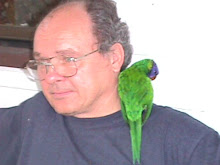 Marbled Frogmouth. Image via ozanimals.com
Marbled Frogmouth. Image via ozanimals.com Nocturnal species along Allen Road are literally few and far between so you can imagine our excitement when last week [26 March] we heard the distinctive call of a previously unrecorded night bird. It was the seventh night-time bird on our Backyard List.
Diabetes and insomnia go hand in glove. I was wide awake and up in the small hours of the morning, “catching up” on entering my handwritten Backyard List sightings into Bird Journal. The call came from the northwest quadrant and sounded close. My initial reaction had been of a Southern Boobook Ninox novaeseelandiae with a sore throat. It wasn’t of course.
Under normal circumstances, if being up and about regularly at around 0300 hours can be described as normal for someone in a diurnal occupation, I would allow Fay to sleep through to breakfast at a more reasonable 0500. On the other hand I have a vivid imagination and could foresee a few uncomfortable moments if I later revealed the presence of a new Backyard List species, indeed a mega addition, and had allowed her to sleep through the experience.
An early morning cuppa and the BOCA discs set to the nightbirds overcame any displeasures Fay may have felt at being stirred [not shaken] before the time set on her alarm clock.
The discs simply confirmed that the identification was incontrovertible. We were listening to a Marbled Frogmouth Podargus ocellatus!
It was the first nocturnal addition to our list since the Powerful Owl Ninox strenua back in October 2008 and that bird had also initially called from the northwest quadrant. And yes, I had been up and about, only on that occasion I was ensconced on the north verandah – October nights can be rather warm and the yellow light bulb helps keep the bugs away.
The Powerful Owl had been the first new nocturnal entry in more than six years. Our Eastern Barn Owl Tyto javanica first appeared on the scene back in August 2002 and has become an irregular feature of the witching hours ever since.
Remarkably enough, the first four nocturnal species were all recorded in our first year at Allen Road [2001]. Top of the List was the Australian Owlet-nightjar Aegotheles cristatus and the only entrant that we saw before ever hearing it. Our immediate neighbour [sharing the eastern fence-line] had a large, old tree remnant with a number of suitable hollows along its entire length. We spotted the owlet-nightjar depart from one of the upper hollows a few hours into dusk and thereafter heard it on a regular basis. Sadly, when Fred sold up, the new owners, with two small children in tow, proved to be rather paranoid regarding snakes and wizened trees too close to the house. The old hollowed stump was felled. The Australian Owlet-nightjar disappeared in September 2003.
September 2001 was a comparatively bumper time for nocturnal additions. The Southern Boobook was first heard on the 1st of that month. It has become among the more regular night-callers along Allen Road.
 The vision of our first Tawny Frogmouth Podargus strigoides will remain eternally etched in our memories. We’d been hearing the call for some time previously. Back in those days there was no house, only a shed, a campervan and a campfire. A few feet from the campfire is a tall gum with a horizontal branch protruding out perhaps a metre and a half from the base. We’d just eaten and were enjoying the first sip of a rather pleasant shiraz when we were suddenly distracted by a quick movement. There had been no sound, no whoosh of wings, no sighing of bent branches, or rustle of disturbed leaves. The frogmouth simply alighted as silently as a ghost on the aforementioned horizontal branch. It remained perched there for what seemed a age but in reality was probably no more than a few minutes. It seemed as curious of us as we were excited at seeing it. My camera was still in the nearby campervan but neither of us dared move a muscle; we were transfixed.
The vision of our first Tawny Frogmouth Podargus strigoides will remain eternally etched in our memories. We’d been hearing the call for some time previously. Back in those days there was no house, only a shed, a campervan and a campfire. A few feet from the campfire is a tall gum with a horizontal branch protruding out perhaps a metre and a half from the base. We’d just eaten and were enjoying the first sip of a rather pleasant shiraz when we were suddenly distracted by a quick movement. There had been no sound, no whoosh of wings, no sighing of bent branches, or rustle of disturbed leaves. The frogmouth simply alighted as silently as a ghost on the aforementioned horizontal branch. It remained perched there for what seemed a age but in reality was probably no more than a few minutes. It seemed as curious of us as we were excited at seeing it. My camera was still in the nearby campervan but neither of us dared move a muscle; we were transfixed.At the end of December 2001, and again I was out on the north verandah tapping away at the keyboard, we heard the unmistakable booming of the White-throated Nightjar Eurostopodus mystacalis coming from somewhere over the western boundary. We last heard it in April last year [2010].
We prefer to disregard the record of Papuan Frogmouth Podargus papuensis listed on DERM’s Wildlife Species List for the South Burnett region. It is hundreds, nay in access of thousands, of kilometres out of its accepted range and was, anyway, last sighted in 1908.

No comments:
Post a Comment